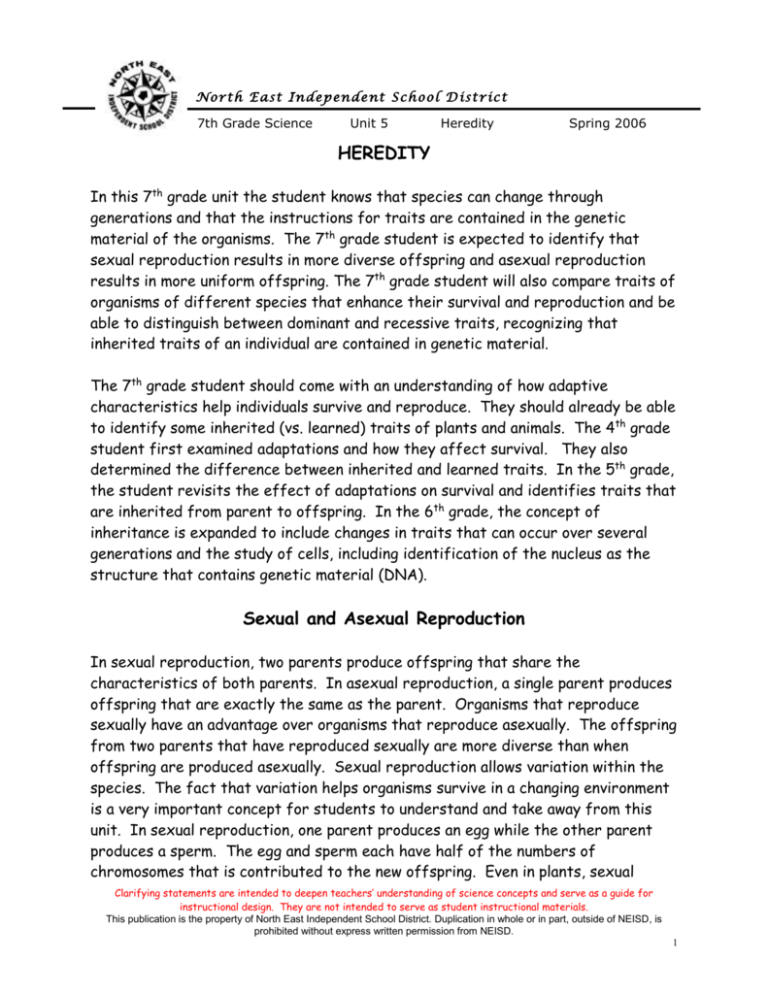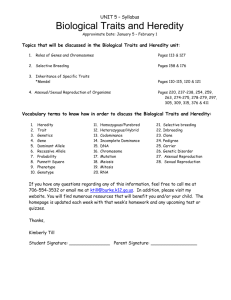7th grade heredity - North East Independent School District
advertisement

N o r t h E a st I n d ep en d e nt S c h o o l D i st ric t 7th Grade Science Unit 5 Heredity Spring 2006 HEREDITY In this 7th grade unit the student knows that species can change through generations and that the instructions for traits are contained in the genetic material of the organisms. The 7th grade student is expected to identify that sexual reproduction results in more diverse offspring and asexual reproduction results in more uniform offspring. The 7th grade student will also compare traits of organisms of different species that enhance their survival and reproduction and be able to distinguish between dominant and recessive traits, recognizing that inherited traits of an individual are contained in genetic material. The 7th grade student should come with an understanding of how adaptive characteristics help individuals survive and reproduce. They should already be able to identify some inherited (vs. learned) traits of plants and animals. The 4th grade student first examined adaptations and how they affect survival. They also determined the difference between inherited and learned traits. In the 5th grade, the student revisits the effect of adaptations on survival and identifies traits that are inherited from parent to offspring. In the 6th grade, the concept of inheritance is expanded to include changes in traits that can occur over several generations and the study of cells, including identification of the nucleus as the structure that contains genetic material (DNA). Sexual and Asexual Reproduction In sexual reproduction, two parents produce offspring that share the characteristics of both parents. In asexual reproduction, a single parent produces offspring that are exactly the same as the parent. Organisms that reproduce sexually have an advantage over organisms that reproduce asexually. The offspring from two parents that have reproduced sexually are more diverse than when offspring are produced asexually. Sexual reproduction allows variation within the species. The fact that variation helps organisms survive in a changing environment is a very important concept for students to understand and take away from this unit. In sexual reproduction, one parent produces an egg while the other parent produces a sperm. The egg and sperm each have half of the numbers of chromosomes that is contributed to the new offspring. Even in plants, sexual Clarifying statements are intended to deepen teachers’ understanding of science concepts and serve as a guide for instructional design. They are not intended to serve as student instructional materials. This publication is the property of North East Independent School District. Duplication in whole or in part, outside of NEISD, is prohibited without express written permission from NEISD. 1 N o r t h E a st I n d ep en d e nt S c h o o l D i st ric t 7th Grade Science Unit 5 Heredity Spring 2006 reproduction can be found. One part of the plant may produce pollen (which is the male part) and another part of the plant may produce the fruit (which has seeds and is considered the female part). Examples of asexual reproduction would be shoots, runners, cuttings, and buds. Unless a mutation occurs, the offspring that is a product of asexual reproduction will be identical to the parent organism because the chromosomes being inherited are simply copies of what the parent has. Students at this level do not need to know the processes of mitosis and meiosis. These processes will be introduced in high school biology. Traits and Genetic Material Gregor Mendel, an Austrian monk who lived in the 1800’s, is known as the father of genetics. Genetics is the study of heredity. Even though Gregor Mendel did not know about chromosomes and DNA (discovered in 1953), he was still able to mathematically figure out which trait was dominant and which trait was recessive. He chose the garden pea for his studies. During experiments in which he mated the plants, he began to notice patterns of inheritance which enabled him to predict the probability of a particular trait be inherited. As a result, he proposed the concept of dominant and recessive genes. His ideas were based on careful observation, record-keeping, and mathematics. Dominant and Recessive Traits Genes are segments of DNA that give instructions to the cell for expressing traits. In sexual reproduction, each parent contributes one set of genes to the offspring. The offspring gets two forms of the same trait for every characteristic, one from each parent. The different forms of a gene are called alleles. The combination of alleles an organism inherits from its parents is the genotype. An organism’s appearance that occurs as a result of the alleles is its phenotype. When two different alleles for a trait occur together, the dominant trait will be expressed. The one that is not expressed when the dominant form of trait is present is considered to be recessive. A expression of a recessive gene is “hidden” by the dominant one. Clarifying statements are intended to deepen teachers’ understanding of science concepts and serve as a guide for instructional design. They are not intended to serve as student instructional materials. This publication is the property of North East Independent School District. Duplication in whole or in part, outside of NEISD, is prohibited without express written permission from NEISD. 2 N o r t h E a st I n d ep en d e nt S c h o o l D i st ric t 7th Grade Science Unit 5 Heredity Spring 2006 Alleles are represented with capital and lowercase letters. The letter of the alphabet chosen should match the dominant trait. The dominant trait should also be the one written with a capital letter. For example, an allele for pea pod shape would be S because smooth is dominant. The recessive characteristic is bumpy and would be referred to with a lowercase s. When two different alleles occur together, such as Ss, the dominant allele will be expressed, resulting in a smooth phenotype. This is a student’s first introduction to dominant and recessive traits. In the example given above, the student should be able to recognize which genotypes lead to a dominant expression in the phenotype and how the recessive genotype is the only one that will lead to a recessive expression in the phenotype. For example, students should know that SS and Ss plants would both be smooth and only ss plants would be bumpy. Students are never expected to know which trait is dominant over another. This information must always be provided by the teacher. The 8th grade student will expand on this information through the use of punnett squares to make predictions about possible outcomes of genetic combinations. The following chart contains some examples of traits in humans that are controlled by a single pair of alleles: DOMINANT TRAITS RECESSIVE TRAITS unattached earlobes attached earlobes straight thumb hitchhiker’s thumb Source: http://extension.usu.edu/aitc/teachers/pdf/heredity/comparing_traits.pdf can roll tongue Source: http://extension.usu.edu/aitc/teachers/pdf/heredity/comparing_traits.pdf cannot roll tongue Clarifying statements are intended to deepen teachers’ understanding of science concepts and serve as a guide for instructional design. They are not intended to serve as student instructional materials. This publication is the property of North East Independent School District. Duplication in whole or in part, outside of NEISD, is prohibited without express written permission from NEISD. 3 N o r t h E a st I n d ep en d e nt S c h o o l D i st ric t 7th Grade Science Unit 5 DOMINANT TRAITS freckles Source: http://extension.usu.edu/aitc/teachers/pdf/heredity/comparing_traits.pdf Heredity Spring 2006 RECESSIVE TRAITS no freckles Source: http://extension.usu.edu/aitc/teachers/pdf/heredity/comparing_traits.pdf naturally rests left thumb on top when hands are folded dimples naturally rests right thumb on top when hands are folded middigital hair no middigital hair widow’s peak no widow’s peak no dimples Natural Selection Students have studied adaptations since the 4th grade. This is the first time, however, that natural selection will be discussed. Natural selection is a process by which organisms with certain traits survive and reproduce at a higher rate than organisms without these traits. Natural selection explains how a population can change over time and why some traits are more beneficial than others. Environments also change, and sometimes they change too quickly. When this happens, the organisms will either die out or the few with the right adaptations will survive and pass their traits on to their offspring. The theory of natural selection has four main points: overproduction, genetic variation, struggle to survive, and successful reproduction. overproduction: In an effort to allow a population to survive most organisms will produce more offspring than is needed. In general, the more parental care needed, the fewer the offspring. In some cases, more offspring are Clarifying statements are intended to deepen teachers’ understanding of science concepts and serve as a guide for instructional design. They are not intended to serve as student instructional materials. This publication is the property of North East Independent School District. Duplication in whole or in part, outside of NEISD, is prohibited without express written permission from NEISD. 4 N o r t h E a st I n d ep en d e nt S c h o o l D i st ric t 7th Grade Science Unit 5 Heredity Spring 2006 produced to increase the odds of survival for species that are not well protected by parents. genetic variation: Among the many individuals of a single population of species there exists variation or different forms of a trait. Some forms of the trait may be more advantageous than others, depending on the environment. struggle to survive: All species compete for food, water, air, and habitat (a place to live). Those species that have the adaptations best suited to the environment are the ones most likely to survive. successful reproduction: Individuals do not have to reproduce in order to survive, however, some individuals in a population have to reproduce or the species will die out. The organisms that are best adapted are going to be the ones who reproduce and this allows the species to continue its survival in nature. The 7th grade student needs to know that some traits enhance survival and as a result, lead to greater chances of reproducing and continuing the species. The following pictures and chart provide some examples of adaptations: Clarifying statements are intended to deepen teachers’ understanding of science concepts and serve as a guide for instructional design. They are not intended to serve as student instructional materials. This publication is the property of North East Independent School District. Duplication in whole or in part, outside of NEISD, is prohibited without express written permission from NEISD. 5 N o r t h E a st I n d ep en d e nt S c h o o l D i st ric t 7th Grade Science Unit 5 Heredity Spring 2006 Clarifying statements are intended to deepen teachers’ understanding of science concepts and serve as a guide for instructional design. They are not intended to serve as student instructional materials. This publication is the property of North East Independent School District. Duplication in whole or in part, outside of NEISD, is prohibited without express written permission from NEISD. 6









